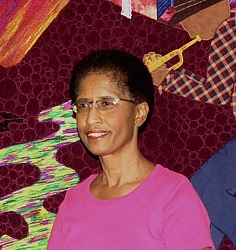Misplaced by History: Artists Worth Knowing
Gwendolyn (Gwen) Ann Magee
“The art flows through me but does not belong to me alone. It speaks for those who have no voices, whose voices have been ignored, whose voices have been silenced. It relates history and circumstances that must not be forgotten.”
Gwendolyn (Gwen) Ann Magee
Gwendolyn (Gwen) Ann Magee (1943 – 2011) was an African-American fiber artist. Magee learned to quilt in mid-life and quickly became known for her powerful abstract and narrative quilts depicting the African American experience. Her art was informed by her participation in the civil rights movement, careers in social work and business, and her experiences as a wife, mother, and grandmother.
Magee’s childhood in North Carolina was spent surrounded by art publications and visits to museums in New York with her adoptive mother, a schoolteacher. Fascinated with color, Magee recalled trying to dig into paper with crayons to achieve the depths and intensities that could match the brilliant hues in her mind’s eye. The power of color became a signature of her mature work.
Magee enrolled in the Woman’s College of the University of North Carolina (UNC) in Greensboro. UNC was in its fourth year of desegregation, and Magee was one of five African Americans in her class. Greensboro was a center of civil rights activities, and Magee became active in local demonstrations against segregation in the community, an experience that would later influence her artistic vision.
Following her graduation in 1963 with a B.A. in sociology, Jones continued graduate study in social science at Kent State and Washington universities. She married D. E. Magee, an ophthalmologist in 1969. The couple moved to Jackson, Mississippi, where they established careers and raised two daughters.
Wanting to make quilts for her daughters to take to college, Magee enrolled in a quilting class in 1989. That class lead to increasing interest in quilting, particularly as it related to other African American quilters. Initially working in traditional quilting methods, she soon moved into abstract designs, and then references to African culture using textile and design traditions. Her vision expanded to include her concern with social justice and African American history and culture.
Throughout the 1990s and 2000s, Magee used her quilts to bring attention to racial injustices of the past and the present. Many of her quilts, including When Hope Unborn Had Died, narrate the impact of slavery in the United States. From 2000 to 2004, Magee worked on a series of twelve quilts inspired by the song “Lift Every Voice and Sing” by James Weldon Johnson. Through her textile art, Magee has also responded to contemporary events. In response to the state of Mississippi voting to keep the Confederate battle cross in their state flag, she created Southern Heritage/Southern Shame in 2001, with layered images of the Confederate flag,
Said Magee, “I see art as a form of communication, a conversation between me, the artist, and the viewer. Each viewer brings different experiences, interacts with the work differently, even if it is two friends standing side by side.”
Magee felt her quilts spoke a language that everyone could understand. “My hope is that anyone, no matter what their race or culture, will relate to the work, find something that speaks directly to them. Hopefully, it will continue to speak to people years after I am gone.” She died in Jackson in 2011, age 67, after battling a long-term illness.
Magee’s work can be found in the permanent collections of the Mississippi Museum of Art, the Museum of Mississippi History, the Michigan State University Museum, and the Renwick Gallery of the Smithsonian Museum of American Art, and has been exhibited internationally.



